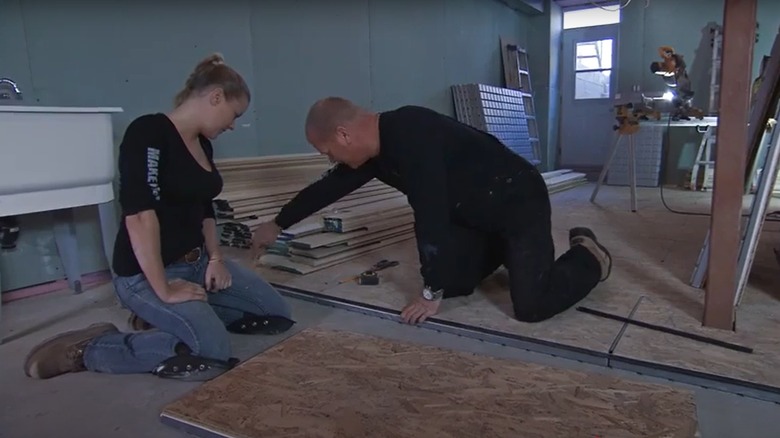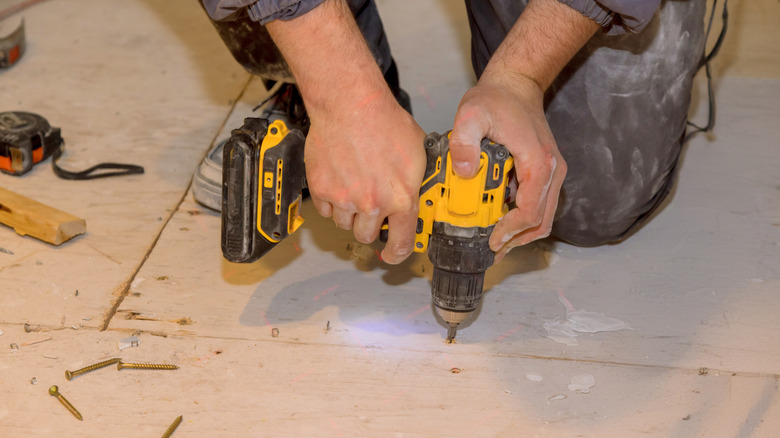Mike Holmes' Expert Advice On Choosing The Right Type Of Subflooring
We may receive a commission on purchases made from links.
If you are seeing signs that your home's subfloor needs to be replaced, you want to be sure to pick the right material to do the job. Subfloor doesn't receive the same attention as the vinyl planks or natural hardwood that you select for the main flooring product, but it still requires some consideration. Mike Holmes, who is the host of "Holmes on Homes" on HGTV and is a professional contractor, emphasizes the importance of picking the right type of subfloor to protect your items from moisture.
"I'm a big fan of subfloors and I have been for many years because they serve a lot of purposes," he said in a YouTube video. Selecting the right type of material to use depends on the location where you'll be doing the installation and what type of base exists, he says.
Such precautions are especially important in areas of the house where you may have moisture, such as the basement, kitchen, or bathroom. You need protection from dampness for the main flooring that you select, such as engineered hardwood or tiles. Without protection against moisture, any water that spills on the surface could become trapped underneath the main flooring product. This could lead to mold lurking in your home underneath your floors, leaving you to deal with potentially expensive mold remediation or even floor replacement. Choosing the right subfloor, however, could prevent this issue before it starts, and Holmes' advice can lead you to make the correct choice for your specific situation.
How to choose a moisture-resistant subfloor
Although some flooring experts may suggest simply laying a sheet of thin plastic over the concrete foundation in the basement to create a vapor barrier before putting down your preferred flooring material, Holmes does not recommend this approach. He says that any moisture that seeps through the porous concrete foundation could become trapped under the plastic. The plastic may protect the main flooring material from water, but mold likely will begin forming under the plastic.
Instead, he suggests using a product called Amdry Insulated Subfloor Panels when going over concrete in the basement. "This product, I got to tell you now, I've been looking and paying attention, and [it's] a product that makes total sense to me," Holmes said on YouTube. "By laying this on the floor, what we're doing is thermally breaking through the bottom."
The Amdry subfloor panel consists of a moisture-resistant high-impact polystyrene (HIPS) film on the bottom that has small moisture channels cut into it. An oriented strand board (OSB) sits on top, creating a sturdy layer over which to lay the new flooring. OSB is a popular subfloor in a home renovation. The HIPS layer protects the OSB — and the main flooring product you'll install over the top of it — from any moisture, and prevents condensation by forming a temperature barrier, too.
How Mike Holmes recommends installing your subfloor panels
The Amdry subfloor panels consist of a roughly 1 inch HIPS layer and a roughly 5/8-inch OSB layer. To attach the panels to the concrete, Mike Holmes recommends using Tapcon screws, which are a special type of screw able to go through concrete or blocks. The threads on Tapcon screws cut the concrete without breaking it, allowing for a secure connection. Tapcon screws are available in lengths ranging from 1 1/4 inches to 6 inches, but you'll need a long enough screw to go through the 1.6 inches of the Amdry subfloor panel and secure to the concrete.
After attaching the panels to the concrete in the basement, he recommends using a low-expansion spray foam around the edges and a product like Tuck Tape Construction Sheathing Tape to cover all the seams in the panels before installing the main floor over the top. Tuck Tape is made specifically to seal joints for a leak-free finish.
For an upper-floor kitchen or bathroom, Holmes says you could use the Amdry subfloor panels over the existing subfloor. If you need a thinner material, you could use a waterproof underlayment like the Schulter Ditra-XL Uncoupling and Waterproofing Membrane, especially if you plan to install tile floors.


